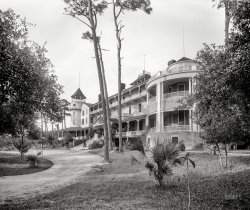
MAY CONTAIN NUTS

Search Shorpy
SHORPY ART

Framed or unframed, desk size to sofa size, printed by us in Arizona and Alabama since 2007. Explore now.
Join and Share
Ad-Free Shorpy
Shorpy is funded by you. Patreon contributors get an ad-free experience.
Learn more.

Recent comments
- Details, Details
- What's that building to the left of the tower?
- Coal Barges
- Bromo-Seltzer
- Inner harbor
- The Basin
- What a headache!
- Giant stepladder?
- Baldwin 62303
- Baldwin VO-1000
- Cold
- No expense spared
- Tough Guys
- Lost in Toyland
- And without gloves
- If I were a blindfolded time traveler
- Smoke Consumer Also Cooks
- Oh that stove!
- Possibly still there?
- What?!?
- $100 Reward
- Freeze Frame
- Texas Flyer wanted
- Just a Year Too Soon
- WWII -- Replacing men with women at the railroad crossing.
- Yes, Icing
- You kids drive me nuts!
- NOT An Easy Job
- I wonder
- Just add window boxes
Member Photos
The Shorpy
Print Emporium
Print Emporium
Search Shorpy
Search results -- 30 results per page
- Texas Roundup: 1901
- ... wagon on a Texas roundup." Dry plate glass negative by William Henry Jackson, Detroit Publishing Co. View full size.
Little Joe the ... Posted by Dave - 07/20/2012 - 1:38pm -
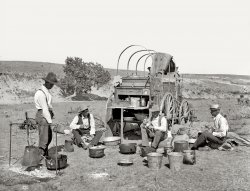
- Amorita: 1900
- ... M.I. Jackson -- a relative of Detroit Photographic partner William Henry Jackson, who probably took the photo.
(The Gallery, DPC, Portraits) ... Posted by Dave - 07/26/2012 - 4:58pm -
![Amorita: 1900 Circa 1900. "Amorita." The beguiling lass previously seen in the guise of Thisbe, now more exotically trimmed. Detroit Publishing glass negative. View full size.
Keep diggingThere has to be a Venus picture there somewhere!
A tasty wrapWonder if we're meant to think that's sheets/blankets/drapes (despite the fact that she's sitting in a chair), or an actual heavily embroidered gown.
Would she be on MTV?I get the feeling she would be on a reality show today.
Risque BusinessShe seems delightfully prone to bad behavior.
Femme de SiecleI can only imagine what men of her age thought at the time. As for me, I'm in love.
Desperately Seeking AmoritaScouring old newspapers for "Amorita" ---
1901: "... The new head sails and the decrease of weight above and the increase of weight below the water line had made a wonderful change. It was found that to windward in a strong breeze she could beat the Quissetta readily...."
Wait! That's Amorita the racing yacht. Let's see. . . .
1909: "... Her mantle fell upon Maasdam & Wheeler's Amorita. She is a strong, useful mare of the broody type." Wait! That's Amorita the champion horse (though I like the "broody" part)....
1911: "She is broad, deep bodied, well mounted and shows the real Percheron type." Wait! That's the horse again (I think). Let's see....
Haughty + NaughtyShe would be good for an example of "haughty"! Lovely but truly dangerous. What's the line from that movie -- "poison under the gravy"? Suits her to a T.
She CouldWhip me, beat me, make me write bad checks. And all the while, I would grin like an imbecile. Just happy to be under to be under her spell.
Lovely!I still think she's wonderful. I wonder if her skin was that lovely in person.
MuchalikeShe looks like she stepped out of one of Alphonse Mucha's illustrations!
Imagination is AllI think the point of the photos isn't for us to know whether that is a blanket or drape or gown but for us to believe whatever we want to believe. The situation might have been entirely chaste - her dress worn in such a way that her arms and shoulders could be exposed - but our eyes see this image and our minds decide for us whether she or not she was nude under that. That's the thing about art; so much of what we see in it is what we put into it ourselves.
Teen AngelGood Lord in heaven, she's beautiful!
ShouldersAmorita; I love your shoulders.
Foy
(punctuation challenged)
GloomyI see, there is somewhat gloom in her eyes. Guess she just lost her man.
LoveI've been in love with this young woman since first seeing her other pics sometime ago. Thisbe? Amorita? I wonder what her real name was. I suppose we will never know.
Who is she?Does anyone know, who the photographer was and who she is? Please help.
[Subject is unidentified; photographer is unnamed employee of the Detroit Publishing Company. - tterrace]
This is Evelyn Nesbit [Not]I believe the model is Evelyn Nesbit, the original Gibson girl (and "the girl on the red velvet swing"). Although she was not a Barrymore, she was romantically linked with John Barrymore. Just a coincidence that she looks so much like Drew!
[Below, two photos of Evelyn Nesbit above two pics of our model here. Not the same person. - Dave]
M.I.J."Amorita" is identified on the negative as one M.I. Jackson -- a relative of Detroit Photographic partner William Henry Jackson, who probably took the photo.
(The Gallery, DPC, Portraits)](https://www.shorpy.com/files/images/4a05741a.thumbnail.jpg)
- Splash: 1889
- ... 1889. "Bathing pool in the Casino." The swimming pool at Henry Flagler's Hotel Alcazar in St. Augustine, Florida, last seen here from the other end . Glass negative by William Henry Jackson. Detroit Publishing Co. View full size.
Seeing ... Posted by Dave - 09/01/2009 - 5:33pm -
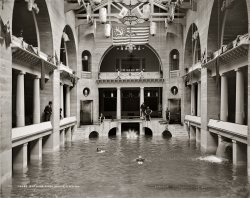
- The Old French Market
- ... "The old French Market, New Orleans." Photo by William Henry Jackson. Detroit Publishing Co. glass negative. View full size.
... Posted by Dave - 03/13/2019 - 10:53pm -
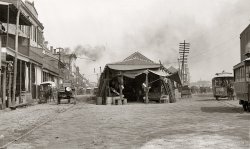
- Ponce Parlors: 1890
- ... "Parlors of the Ponce de Leon Hotel." Glass negative by William Henry Jackson. Detroit Publishing Co. View full size.
The anti-Bauhaus ... Posted by Dave - 07/20/2012 - 1:35pm -
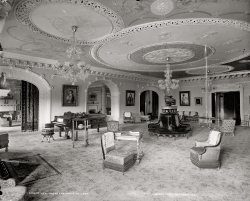
- Rue Saint-Jacques: 1901
- ... Montreal, Quebec." 8x10 inch dry plate glass negative by William Henry Jackson, Detroit Photographic Company. View full size.
No es ... Posted by Dave - 06/16/2022 - 9:05pm -
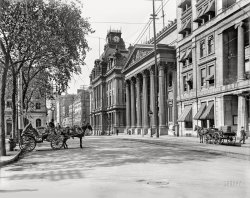
- Saltair: 1900
- ... Great Salt Lake." 8x10 inch dry plate glass negative by William Henry Jackson, Detroit Publishing Co. View full size.
If you really ... Posted by Dave - 07/20/2012 - 1:36pm -
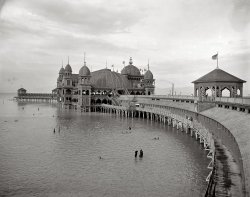
- Florida Mammoth: 1890s
- ... the bow of the Princess . 8x10 inch glass negative by William Henry Jackson, whose photographs formed the basis of Detroit Publishing's ... Posted by Dave - 07/19/2012 - 12:54pm -
![Florida Mammoth: 1890s Florida in the 1890s. "Brown's Landing, Rice Creek." Note the enormous 18x22 inch "mammoth plate" view camera set up on the bow of the Princess. 8x10 inch glass negative by William Henry Jackson, whose photographs formed the basis of Detroit Publishing's holdings in the company's early days. View full size.
He hauled it Into the mountains, tooWilliam Henry Jackson's 18x22 inch glass plate photographs are a mainstay among Colorado history buffs, particularly railfans. Some of his locations seem accessible only to mountain goats. Unfortunately, most of these do not appear to be part of the LOC collection.
[The Library of Congress has the non-Western photos that the Colorado Historical Society didn't want. - Dave]
The Denver Public Library has some of them.
Where's Bogie and Katie? Some very pleasing visual effects on the boat. Notice the ox-yoke formed by the sculpted "Princess" plate over the wheelhouse window, much like the classic Packard grill. The curlicue shapes on each side of the bow (is there a proper name for them?) add a nice touch as well, as does the shaped wheelhouse roof---complete with eagle.
UGH!What did these poor guys use for mosquito repellent back then?
We honeymooned in Florida in May. Near a slow-moving body of water the mosquitoes were so big they could make one feel faint from loss of blood. The beaches - which had brisk, mosquito-repelling breezes - were wonderful!
Love TriangleAnd note the 3rd camera on the tripod over on the right, keeping a jealous eye on the other two cameras.
Third cameralocated to the right side of the picture on the landing. Much more conventional. One assumes it's like the one that took this shot.
No turn of the keyJust think what it took to get one of those steamboats under way. No "turn the key and cast off." And if the skipper / proprietor was lucky he had help to split, haul and stow the firewood.
Where's the princess? Note the running lights on that boat. They followed the rules of the road on that little river. I was in Florida in 1938-39. My mother particularly liked the flying cockroaches. The ones we were used to in New York couldn't do that.
(The Gallery, Boats & Bridges, DPC, Florida, W.H. Jackson)](https://www.shorpy.com/files/images/SHORPY_4a03508a.thumbnail.jpg)
- Horsecar Opera: 1890
- ... Fascinating details abound in this scene captured by William Henry Jackson: The 1-horsepower horsecar, the ancient carbon-arc lamp suspended ... Posted by Dave - 08/14/2012 - 3:42pm -
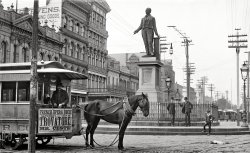
- To Boiling Spring: 1902
- ... Oklawaha." Don't forget your flotation bonnets! Photo by William Henry Jackson, Detroit Publishing. View full size.
I'm Wide Awake ... Posted by Dave - 08/14/2012 - 8:27pm -
![To Boiling Spring: 1902 Florida circa 1902. "Silver Springs on the Oklawaha." Don't forget your flotation bonnets! Photo by William Henry Jackson, Detroit Publishing. View full size.
I'm Wide AwakeAnd I agree with Slump; this picture has a curious dream-like perspective to it. It's as if the figure in the background is the actual subject of the shot and the ladies in the boat just happened to be there. He seems to be posing for the picture too as if he knew he was the focal point.
It looks like a still from a movie.If that movie was made by David Lynch.
This gives me an ideaFor a comic strip set in a funny-named swamp with animals getting into hilarious situations, topical satire, and flat bottom boats bearing different names.
Looking for the yearling...One of those ladies might be Marjorie Kinnan Rawlings, searching out her muse.
Movie?My take on it is David Wark Griffth filming Lilian Gish in her prime.
Hatted and coiffedWell, at least the hats don't look silly. You could hide cannonballs under those things.
That guy on the roof of the boatIs looking really hard for a glimpse of wrist!
That man in the backThat character in the background sitting on the canopy (?) of that boat (??) looks like he might have jumped straight out of a Toonerville Trolley cartoon.
Flotation DevicesLooks like the lady on the left has more than just her bonnet to keep her afloat unless that's just the wind.
I'm off to bedAnd this photo has the makings of a very odd nightmare.
100 Years LaterNow there's your nightmare.
Where's the sweat?Something always puzzles me about these things. Florida is so hot and humid almost year round yet in the old photos people are always dressed so hot.. I break out in a sweat just looking at this one ... did they not perspire?
[Florida was a winter resort -- not many people went in the summer. As someone who was born in Miami and grew up in Florida, I can assure you that it's not "hot and humid almost year round." - Dave]
HeadgearI love those ancestral sun bonnets that add to the peaceful look of the women in this picture. The only place we get to see one today, is occasionally, on a baby in a pram.
We have met the enemy and he flings poo. The comment by "Walt Kelly" isn't too far from the truth, with a cast of characters suitable for lampooning. Substitute 'flat' for 'glass' bottom boat (where it was invented), consider that Tarzan made an appearance, and how the story goes that a scenic boat promoter in the 30's let monkeys loose on an island not knowing they could swim, leading to roving bands of them along the river to this day.
Boiling hotWhat always strikes me about pictures of this era is how white the whites are. These bonnets practically glow! Even when photographed in the woods, on a train, at the beach, etc., these ladies all looked immaculate. Testimony (I guess) to lots of boiling water and scrubbing. I can't make it from my house to my car in white pants without having to turn around and change. Yipes.
Fish CampThis is great! With better-maintained boat houses, a big wide dock with picnic tables and-of course-modern fashions, this could easily be any of the present-day "rustic" fish camps up and down the St. Johns River and lots of other places in Florida. All you need to fill the shot are some egrets and herons and a manatee floating by.
(The Gallery, Boats & Bridges, Florida, W.H. Jackson)](https://www.shorpy.com/files/images/4a09436a.thumbnail.jpg)
- St. Paul P.O.: 1902
- ... Paul, Minnesota." 8x10 inch dry plate glass negative by William Henry Jackson, Detroit Publishing Company. View full size.
Still with ... Posted by Dave - 07/20/2012 - 1:39pm -
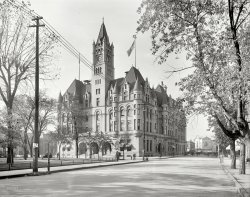
- Cowpokes: 1901
- ... nattily attired gent from the chuck wagon scene. Photo by William Henry Jackson. View full size.
A lot of cows to poke Photographs out ... Posted by Dave - 07/20/2012 - 1:38pm -
![Cowpokes: 1901 Circa 1901. "A group of Texas cowboys." Including the nattily attired gent from the chuck wagon scene. Photo by William Henry Jackson. View full size.
A lot of cows to pokePhotographs out in the wild like this were not undertaken as casual snapshots. Possibly Mr. William Henry Jackson arrived on the scene with his developing tent, crew of helpers, large tripod-mounted view camera, and a reputation. I can imagine him directing the "actors" in an event that lasted a fair amount of time. Almost nobody smiles in these old photographs, because having one's likeness preserved for eternity (here we are looking at the image 109 years after it was made) was a serious matter and no one wanted to look silly or insubstantial. This might be the only photograph some of these men would have taken in their entire lives, so it was a sober occasion, hence the crisp white shirts, starched collars, and even a bow tie. It's a wonderful picture - I'm going out to buy a new hat.
[W.H.J. did not just travel with a tent. He had a train. - Dave]
PerfectionSweet mercy Dave! How perfect is your timing? Completely, as always.
In less than a month and a half, there will be a whole slew of Texas Cowboys decending upon my beloved Houston for the Houston Livestock Show and Rodeo. It wouldn't be surprising if there will be a few cowboys and cowgirls akin to these Cowpokes in this lovely photo attending the world's largest Livestock Show and Rodeo. Who knows? Mayhaps this cattle line still exists.
I absolutely adore this picture!
Cattle driveLooks like over a thousand head of cattle behind those cowboys. I'm curious why you can't see any guns. They would have to have some Winchester rifles and a few handguns on a long drive it seems. Unless, could it be about no firearms while on their horses so that no shots could be fired while acually driving the cattle. Maybe shots fired could cause a stampede and scatter the whole herd.
Surely ChisholmI'd bet these wranglers are styling their Sunday-go-to-meeting clothes. The shirts and (most) pants are clean, and there are no sweat stains about their headbands. The Texas range radiates like an oven, and it appears the steers are hogging the shade.
Nattily A. TiredThe ranch owner or maybe the foreman.
Bony CrittersSome of those cattle are very thin. Their hip bones and ribs are terribly visible. I am not sure why this would be -- perhaps because of the stress of heat or drought or because of a lack of nutrition in the grass.
Texas cattle, taken north, got fat on the nutritious prairie grasses of the Great Plains. Many an enterprising rancher made money on this knowledge, including my own grandfather during the 1930s.
(The Gallery, DPC, Frontier Life, Horses, W.H. Jackson)](https://www.shorpy.com/files/images/4a09142a.thumbnail.jpg)
- Chattanooga: 1900
- ... at Chattanooga on Mineral Creek." 8x10 glass negative by William Henry Jackson, Detroit Publishing Co. View full size.
Railroad Tie ... Posted by Dave - 09/23/2012 - 1:55pm -
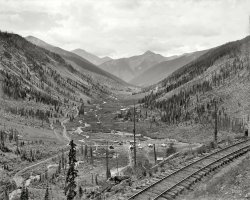
- Ouray: 1901
- ... Blow-out Canyon." 8x10 inch dry plate glass negative by William Henry Jackson, Detroit Publishing Co. View full size.
Hot spring ... Posted by Dave - 04/30/2020 - 2:10pm -
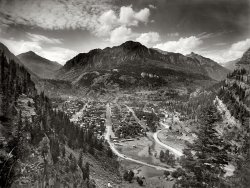
- The Atrium: 1903
- ... atrium, West Baden Springs Hotel." 8x10 glass negative by William Henry Jackson, Detroit Publishing Co. View full size.
Amazing The ... Posted by Dave - 08/14/2012 - 2:38pm -
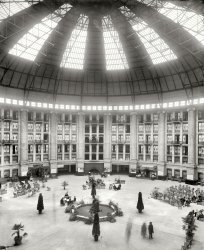
- Spring Break: 1890
- ... T's and Victorian flip-flops. Dry plate glass negative by William Henry Jackson. Detroit Publishing Co. View full size.
The Overlook ... Posted by Dave - 07/20/2012 - 1:35pm -
![Spring Break: 1890 St. Augustine, Florida, circa 1890. "On the roof of the Ponce de Leon Hotel." Then back down to the room, and into our T's and Victorian flip-flops. Dry plate glass negative by William Henry Jackson. Detroit Publishing Co. View full size.
The OverlookCreepy little girl with the veil, reminds me of "The Shining"!
Overheard"My card, Sir! I should like to talk to you about land opportunities in South Florida that come but once in a lifetime."
MarvelousI would love to be able to see the Working Drawings for this building!!
Veiled threadOBVIOUSLY just a blur .. Thanks.
My chills have subsided.
I Can't ImagineWearing all those heavy clothes!
Strange face coveringShould have checked the comments first but I'm wondering what the strange hood is covering the little girl sitting with her mom. I can only guess covering a medical condition that in those times this was the normal way of keeping it a bit private in a formal setting, such as down syndrome or hemangenomas hemangiomas (port wine syndrome).
[Netting on hats was nothing unusual, especially in a buggy climate. But what we have here looks more like motion blur. Check out the Ghost Shoe. - Dave]
Supposition The ladder on the wall must be there in case of fire.
PlaytimeIt looks like the man on the far right is playing a game of catch with the little girl with whatever item he has in his hand. They seem to be much more "footloose and fancy-free" than the two in the middle. Great shot!
Sartorial StereotypeNow we see the origin of the stereotype that older guys in Florida yank their pants up to their ribs.
It was a hot, hot timeI am so grateful I live in an era that allows me to wear, light, comfortable and loose fitting clothing. I'll bet the females are wearing woolen stockings. On a roof. In St. Augustine, Florida. Ugh!
[Remember that "the season" in Florida was winter and spring. So probably not so hot. - Dave]
Catch!It's a beanbag. Haven't played with one of those in years.
We used to make them from a couple of squares of cloth sewn together, filled with dried beans. See how easily amused we were?
Re. Pant-Yanking StereotypesIn defense of the older man: the reason that "older guys in Florida yank their pants up to their ribs" is that the male body changes shape after about the age of forty and the natural waistline migrates upward (also, a gut usually develops about this time). It happens regardless of how hard you work out. The change is slow and imperceptible at first, but by the time you're in your sixties it is just more comfortable to wear one's trousers hiked way up. Don't worry younguns, it'll happen to you too *evil laugh*!
ConstructionA massive concrete building. Note the tile roof. Built for the ages and now Flagler College. The clientele 1890 were the top of society. Those in the picture are dressed accordingly.
The Strange Ladder... gave access to the water tanks on the roof. They still use ladders for access today but the tanks have been replaced with loudspeakers for fake bells.
(The Gallery, DPC, Florida, W.H. Jackson)](https://www.shorpy.com/files/images/4a03457a.thumbnail.jpg)
- Xanadu: 1897
- ... de Leon, Alcazar and Cordova hotels." Glass negative by William Henry Jackson. View full size.
In Xanadu "In Xanadu did Kubla Khan a ... Posted by Dave - 08/13/2012 - 7:57pm -
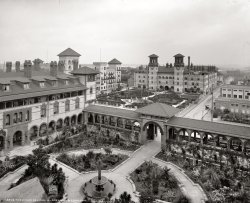
- Mercado de San Marcos: 1890s
- ... "Portales of the market of San Marcos." Glass negative by William Henry Jackson, Detroit Publishing Co. View full size.
Watering Hole ... Posted by Dave - 07/20/2012 - 1:36pm -
![Mercado de San Marcos: 1890s Aguascalientes, Mexico, circa 1890s. "Portales of the market of San Marcos." Glass negative by William Henry Jackson, Detroit Publishing Co. View full size.
Watering HoleHot waters. Sister city to Ojo Caliente, New Mexico. Hats off to you!
Sombrero CentralThere are some mighty fine looking lids in this market. No wonder all of these guys are sporting hats. Well, maybe the sun had something to do with it.
Third Hombre From RightLooks like his interest in hats is taking yours.
What the???Does anyone know what the heck the protrusions from the building opposite are? I could almost imagine them being rifles pointed at the unsuspecting fellows across the way.
[Those are drains. - Dave]
For all your needs...As long as all you need is a hat.
Location?Dave, do we know where this was taken? I mean, in which city? Thanks!
[Aguascalientes, which I have added to the caption. - Dave]
Prosperity!A clean local market. Swept sidewalks, plenty of goods on offer, well maintained buildings, even electric lighting! This is obviously a place of prosperity. Even the young lad in the foreground has that "I'm going somewhere" look about him.
Gives lie to all the spaghetti western portrayals of Mexican towns.
A Fistful of Dollarswould probably buy this entire marketplace (and the employees). I see Lee Van Cleef and Clint Eastwood in earlier days. Now I need to go to Chilino's for my favorite Mexican lunch of chimichangas and refritos frijoles. See what you started?
Packing heatI bet those guys didn't have issues with concealed carry.
You're in Hot Water nowThe protrusions on the building across the street are Mexico's version of rain gutters, a very common site in Mexican architecture.
Having raced in the world famous La Carrera Panamericana, considered the most dangerous and grueling race in the world, I have seen many locations throughout Mexico that resemble this exact scene. In fact when I first saw this photo it looked to be an almost exact replica of the one in Morelia Mexico.
La Carrera Panamericana begins near the Guatemala border and continues all the way back to the United States and Aguascalientes is one of the cities we stop in over night.
When I mentioned this photo to a friend who lives near there he wrote, "It is the Old Parian, the market in downtown Aguascalientes, the picture is from the first version, that was demolished in the 50´s, then the second until the 80s and the new Parian now has many levels including underground parking."
Curious GeorgeNow we know where "the man in the yellow hat" shops.
TimelessThis scene could have been from the 1980s when I lived in Mexico; less has changed than MORE has changed.
The blankets and hats, the portales...all there just twenty years ago. Maybe it still is.
(The Gallery, DPC, Stores & Markets, W.H. Jackson)](https://www.shorpy.com/files/images/4a03687a.thumbnail.jpg)
- Eager for Deer: 1901
- ... deer. Deer-hunting beagles." Circa 1901-1906 photograph by William Henry Jackson. Detroit Publishing Company glass negative. View full size. ... Posted by Dave - 07/20/2012 - 1:34pm -
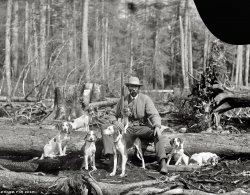
- Fine and Dandy: 1892
- ... latest style." Fashion-forward dry plate glass negative by William Henry Jackson. (UPDATE: This is a self-portrait.) View full size.
... Posted by Dave - 11/03/2012 - 6:16pm -
![Fine and Dandy: 1892 August 1892. "The latest style." Fashion-forward dry plate glass negative by William Henry Jackson. (UPDATE: This is a self-portrait.) View full size.
Bowler with a center dent.That hat looks like a typical bowler worn at the time. This chap has taken it a step further and gave it a simple center crease. Instant Homburg.
Proper decorumI believe the right hand in a partially unbuttoned vest is the more
appropriate, sir. Oh, I see, the watch chain is in the problem.
Mixed genresThe garb says Gay Nineties, the beard says Civil War general, the expression says posing for a postage stamp.
Handy dandyThat tucked right gives him a "lobster boy" look. Then again, that thumb is chewed enough that the rest of the fingers may not have been photogenic.
One Size LargerLooks like he's about to grow out of it. Those hands look as though they've been through quite a lot!
Prince AlbertI guess someone let him out of the can.
Le chapeauI rather like his hat. It's stylish, compact, well designed and sits elegantly on his head. I wish they would come back. Men used to wear fedoras until President Kennedy went sans chapeau in the sixties and started a new fashion trend for men.
Butch Cassidy StylePosing like a bantam rooster but in my opinion. The jacket is too tight. Haberdashery seems to have gone the way of high button shoes and buggy whips and I don't think we will see comfort-loving modern men returning to the excessively disciplined style of dress (like this) in our lifetime. Its hard to beat t-shirts and sweatpants for easy living and I have noticed that lately the "sleep sets" look almost like the "street clothes" so we may all eventually join the infants among us in wearing the "sleep and play" one piece soft jersey zip-ups that babies wear. Heaven help us.
Tiny !By today's norm that model is a very little man. Look a shoulder width, arm length, etc. Very small, but probably typical for the time.
Thumbnail saysWorking man, or maybe outdoorsman. Sure looks the dandy in this shot though.
[He's the photographer. - Dave]
Pants matching the suitThat's a 1970s glitch. Then again, heroin was a legal substance.
That's gotta chafeThose pants look a little (squeak!) high.
If I'm not mistakenthis is a self-portrait.
(The Gallery, DPC, W.H. Jackson)](https://www.shorpy.com/files/images/4a25781a.thumbnail.jpg)
- Picket Fences: 1903
- ... Virginia." 8x10 glass negative by none other than William Henry Jackson. Detroit Photographic Company. View full size.
Ye Olde ... Posted by Dave - 07/20/2012 - 1:40pm -
![Picket Fences: 1903 Circa 1903. "A street in Yorktown, Virginia." 8x10 glass negative by none other than William Henry Jackson. Detroit Photographic Company. View full size.
Ye Olde Main Street.This is Main Street, Yorktown. The first building on the right after the picket fence is still there. Care has been taken to protect and preserve many of the old buildings in this area.
Twain StreetI'm looking to see Tom Sawyer painting the fence, or getting everyone else to paint it.
What a challengeI would be stunned if someone was able to pinpoint this location.
SignageCan anyone read the sign hanging out from a building right down the middle of the road? Really surprised to see any signage in what I thought was a rural area.
[BARGAIN STORE J.R. Hillman & Co. General Merchandise - Dave]
Main Street in YorktownThe house on the right has had the front porch removed and the shoddy looking addition to the beautiful brick house on the left is now gone as well. Both homes appear to have been beautifully preserved and most of the structures seen further down the street on the right no longer exist.
Main StreetThis is Main Street at the intersection of Smith Street. The house on the right is the Cole Digges House and the Nelson House is down the street on the left. The Victory Monument is to the right and slightly behind the camera. A very nice place to visit today as it must have been 250 years ago.
Main Street between Smith and ReadThe satellite view on Google Maps (alas there are no street views) shows that most of these structures are still standing. The impressive brick house on the left is the Nelson House, built ca. 1730 and home of Governor Thomas Nelson, signer of the Declaration of Independence. It faces Main St. and is located on the western corner of Main and Nelson Streets. A picture on Google Maps shows that there is a cannonball embedded between the windows in the pediment facing the camera in the photo above. The frame house with the hipped roof and the attached office on the left is across Nelson St. from the Nelson House.
The house in the immediate foreground at right is the ca. 1760 Dudley Digges House, which survives today sans portico at Main and Smith Streets.
The white house with 3 dormers and the "Bargain Store" sign is the Cole Digges House (father of Dudley), thought to be constructed ca. 1720ff. It is located at Main and Read Streets and now houses the Carrott Tree restaurant.
Google Street View Saysthe three foreground homes are all still standing. The twin smokestacks at the left belong to the house at the NW corner of Main and Nelson. The house in front of it, obscured by the trees, is on the SW corner. The white foreground house on the right has five gables, three of which appear in the photo. It has lost its front porch. In this view the three chimneys on the left are in close alignment with the vintage photo.
View Larger Map
Mud streetsAs charming as this view is, it's hard to imagine what having dirt streets even on the main drag of town would have been like. Imagine just trying to walk down the road. And after a rain, the mixture of mud and horse manure must have been really ... quaint!
Digges HousesThe house in immediate foreground at right is the Dudley Digges House, built ca. 1760 (portico is a later addition, and has since been removed). It has a five-bay facade with interior end chimneys, and outbuildings that were reconstructed by the National Park Service in the 1970s.
The Cole Digges House (Dudley's father) is the white plaster house with the Bargain Store sign in the center background. It was built during the 1720s or later according to the historic structures report prepared by the architectural historians of Colonial Williamsburg. It is owned by the NPS and today houses a restaurant.
I am trying to find something about the house immediately in front of the Nelson House in this photo. It still survives today per Google Maps (along with the attached office), on the other side of Nelson Street at Main Street. Like the Dudley Digges House, it is five bays wide and of frame construction, but with a hipped roof and exterior brick chimneys.
If you look to your left you will see the lovely Addams residence, to the right the is the beautiful home of the Munsters.
Sessions-Pope-Sheild HouseThe house adjacent to the Nelson House was built ca. 1692 on Lot 56 by local carpenter Thomas Sessions. It is of brick construction and not frame, as I erroneously noted below.
According to the York County Historic Resources Survey (2005 update; page 4):
"This one-and-a-half story brick dwelling is considered one of the finest examples of mid-eighteenth century colonial architecture. The building has remained intact for close to 300 years. During the Civil War, the building served as headquarters for Union General Henry M. Naglee following the abandonment of the town by the Confederates. The property has remained in the Sheild family since 1901, and has hosted Presidents Wilson, Harding, Hoover and Franklin D. Roosevelt."
+112Below is the same view from April of 2015.
(The Gallery, DPC, Small Towns, W.H. Jackson)](https://www.shorpy.com/files/images/SHORPY_4a10721a.thumbnail.jpg)
- Nemo on the Tomoka: 1890s
- ... on the Tomoka." 8x10 inch dry plate glass negative by William Henry Jackson, Detroit Publishing Company. View full size.
Then and Now ... Posted by Dave - 07/20/2012 - 1:39pm -
![Nemo on the Tomoka: 1890s Florida circa 1890s. "Boating on the Tomoka." 8x10 inch dry plate glass negative by William Henry Jackson, Detroit Publishing Company. View full size.
Then and NowThat's Florida, but could easily be a scene from "The African Queen." I'm guessing someone from the 1890s wouldn't even recognize the Tomoka today.
[Below, the Tomoka today. - Dave]
Looking for KateI swear, that's Humprey Bogart guiding the African Queen.
S.S. AlligatorA nice selection of mascots aboard. I suppose they're full of holes. And thank goodness you don't need a stack of firewood anymore to take your launch out on the river.
Finding NemoI wonder if Disney's designers found photos of the Nemo when they were putting the Adventureland Jungle Cruise together. The resemblance is pretty striking.
Mirror ImageHey guys, if you look at the reflection you can almost see her ankles!
A modern Odysseus passes the island of the sirens.Unfortunately, this time it seems as though the crew has decided to pay a visit.
The Sirens of FloridaHad a stricter dress code than their Greek counterparts although the lead Siren seems to be ready to show a little scandalous ankle.
(The Gallery, Boats & Bridges, Florida, W.H. Jackson)](https://www.shorpy.com/files/images/4a03546a.thumbnail.jpg)
- Chautauqua: 1890s
- ... was not just a place but a movement. Glass negative by William Henry Jackson. View full size.
Uncomfortable Seats Those hard wooden ... Posted by Dave - 12/13/2016 - 5:34pm -
![Chautauqua: 1890s New York state circa 1890s. "Assembly hall, Chautauqua." Which was not just a place but a movement. Glass negative by William Henry Jackson. View full size.
Uncomfortable SeatsThose hard wooden benches look as uncomfortable as the wooden chairs that are in the Great Auditorium in Ocean Grove, NJ which was built in 1894!
One lonely soulall the way up in the nosebleeds.
ChautauquariansThe Chautauqua Institution is still active and has an online presence:
http://www.ciweb.org/historyarchives/
Education for everyoneNineteenth-century Americans valued education. The Chatauqua movement joined the earlier Lyceum movement, mechanics' institutes, agricultural extension, and land grant colleges in an attempt to bring education to as many people as possible, at any point in their lives. Public radio and television have tried to extend the success of these pioneering institutions.
[And it was motion pictures, the phonograph and radio that helped bang a lot of nails into the Chautauqua movement's coffin. - Dave]
VestigesThere were Chautauquas in many places. I live in the remnant of one near Carlisle, Ohio (which is to say, the middle of nowhere).
Great sound system!I'm not an engineer, but it seems to me this hall was designed with sound in mind. As well as being a platform for a speaker or small musical group, the stage would also have projected sound up to those reflective wooden ceilings. I bet you could hear a whisper from the stage anywhere in that hall. This, plus the circular arrangement of the benches (or pews) would have contributed to an intimate experience for both audience and speaker.
And don't miss the massive organ.There is a wonderful pipe organ custom-built to work with this stage. A highlight from two years ago was the showing of a silent movie starring Zasu Pitts while a talented and energetic organist played the complete original score, accompanying the movie scene-for-scene.
Ocean GroveThe Ocean Grove Auditorium is the kid brother of the Amphitheatre in Chautauqua. The designers took all the details of the original, and adapted it to their location. Almost identical capacity. The one in Chautauqua is built in a natural ravine, whereas the one in Jersey is on the beach. So they tucked the sides in a little and put a balcony all around. The Ocean Grove one has all natual finish on the wood, which makes it look like the inside of a cello, just gorgeous. Chautauqua has that wonderfully drab yellow paint. Ocean Grove has a 10,000 pipe organ. A toss up as to which is better, they're both great venues for a concert.
Sound system not requiredI saw Ethel Merman in what I believe was that same outdoor auditorium in Chatauqua, NY, in the summer of 1977. The sound system wasn't working, but of course with Ethel Merman that didn't matter. Chatauqua at the time was a picturesque vacation town packed with beautiful old houses. I expect it still is.
I've performed on that stageI performed here in my youth as part of an all-county high school orchestra to an absolutely packed house. Picture "The Battle Hymn of the Republic" during a raging thunderstorm.
Chautauqua vs. Ocean Grove, NJ AuditoriumJazznocracy,
Thanks for adding the history about the two venues and their designs. I'm attaching a photo of the Great Auditorium in Ocean Grove, NJ that shows a better view of the design.
American OriginalI'm guessing that this is the original Chautauqua venue in upstate New York. Chautauqua later became a generic name for the traveling tent shows that criss-crossed America during the summers. They featured musicians, jugglers, singers, yodelers, storytellers and always finished with inspirational speakers who's most frequent topics were positive thinking and how to accumulate wealth. They were extremely popular, especially in rural America, and drew capacity crowds.
Still kickingI went to Chautauqua Institute with my exwife's family one summer. A gated community in which private home owners rent their houses to visitors for weeks at a time. The Institute had weekly programs featuring a theme, and lectures, art exhibits and performers were all booked to support the theme. The lake has a beach with sand, there are numerous trails and bike paths but it is indeed a built up community of homes. Performers worked in the open air theatre/amphitheatre and it was really interesting and quaint. The biggest drawbacks were the mosquitoes and black flies.
ChautauquaChautauqua is a wonderful, magical place. The PERFECT place to spend a summer! Check it out!
Totally gone now!This building is now totally demolished. The Institution decided they needed an entirely new structure to go ahead into their next couple of centuries, and has raised it to the ground. They are now building a new "Amp" that will have an orchestra pit that rises and lowers, enormously improved backstage facilities, and many other features. The roof line will be virtually identical, and it will hold about 500 more people. MUCH brouhaha over this project, which I will sidestep.
Here is a webcam that shows the project's progress.
http://ciweb.org/amp-cam
(The Gallery, DPC, W.H. Jackson)](https://www.shorpy.com/files/images/4a03966a.thumbnail.jpg)
- Dragon Slayers: 1897
- ... last glimpsed here. 8x10 inch glass transparency by William Henry Jackson. View full size.
Blase The girl in the boat seems more ... Posted by Dave - 05/11/2020 - 4:48pm -
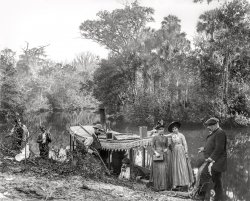
- NCR: 1902
- ... department, National Cash Register Company." Photo by William Henry Jackson, Detroit Publishing Company. View full size.
Quality & ... Posted by Dave - 08/14/2012 - 12:32pm -
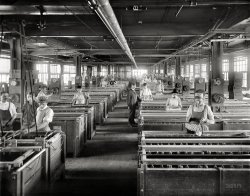
- Dr. Vedder: 1894
- ... circa 1894. "Treasury Street." Dry plate glass negative by William Henry Jackson, Detroit Publishing Co. View full size.
Treasury Street ... Posted by Dave - 08/20/2012 - 10:22am -
![Dr. Vedder: 1894 St. Augustine, Florida, circa 1894. "Treasury Street." Dry plate glass negative by William Henry Jackson, Detroit Publishing Co. View full size.
Treasury StreetDoesn't the sign underneath the "Dr." say Bay Street - or is that alleyway Bay?
[The "alleyway" is Treasury Street -- the subject of the photo. - Dave]
Wilson's PrideOne of the great picket fences ever! Wonderful!
Great marketingGotta love that sign. Dr. Vedder will make you better.
Augustine, here I comeHave seen now several pictures of Augustine. I believe I should have been born there and not in in the wet-feet country Holland.
Clean alleyObviously, the posts at each end kept vehicles (horse-drawn at that time) from traveling down the alley. No back door deliveries on this segment of Treasury St. Also no horse manure on the cobblestones. If men didn't pee there (forgive me, I have lived in a third-world country), it was not a bad-smelling place.
The alley has a slight V-shape, so water drained to the center and may have flowed ... somewhere. A finger of the ocean was a very short distance away, if today's Treasury Street is still in its 1890s location.
Clean alleys are coming back in style. They are an important pedestrian-friendly component of "New Urbanism" neighborhoods. Other elements of New Urbanism include front porches, neighborhood stores, sidewalks, parks, common areas, and smaller lots -- much like an average middle-class 1890s neighborhood.
Dens of AlligatorsDr. John J. Vedder (1819-1899), seen here, was a wealthy retired dentist and business investor from Schenectady, New York, with a passion for the natural history and fauna of Florida. He transformed his residence into a private museum, Vedder's Genuine Curiosity Store, to house his displays of Florida's native species, and learned taxidermy to create his displays. His first cousin, Elihu Vedder, Jr., was the renowned American painter. Dr. Vedder eventually sold his museum to the St. Augustine Historical Society, its first home. Here is an 1886 advertisement for Dr. Vedder's museum.
AmazingThis is, by far, the most amazing photo I've seen on Shorpy yet. It has a time-machine quality to it; you can almost feel what it would have been like to stand there with the good doctor. The image also has a sense of movement - when you look at the gentleman in the distance at the other end of the alley, who is strolling down the street. I'm left wondering, though, what the sign leaning against Dr. Vedder's 1st floor window says.
["Oceanic Sun Fish." - Dave]
LoveThis is the kind of photo I get lost in. Wonderful. I love you Shorpy's.
Family member hereI am a great-great-great grandson of Dr. John Vedder. I have seen several photos of him but this is by far the clearest. There is a similar photograph in the Rollins College Archives. You can read all you care to know about the Vedder Museum here:
http://freepages.family.rootsweb.ancestry.com/~wabnoles/veddermuseum.htm...
Curlicues and flourishesIt's always fascinating to see how commercial signage styles change. One thing you would never expect to see any more is the decorative detail in the D, and that thingy dangling from the V.
A Great TownAn amazing photograph with the kind of clarity that glass plate negatives could give. Dr. Vedders' building was originally the Panton and Lesley office, built during the 1770s British period. They were the licensed Indian traders at the time of the Revolution. It is currently the site of the Hilton hotel, but the short wall in front is still there, retained as an historical artifact, as is Treasury Street itself, touted for years as the country's narrowest thouroughfare. Bay Street is now Castillo Drive, but is still commonly called the Bayfront. It's a great place to visit!
(The Gallery, DPC, Florida, W.H. Jackson)](https://www.shorpy.com/files/images/4a03634a.thumbnail.jpg)
- The Continental: 1902
- ... 1902. "Hotel Continental -- Atlantic Beach, Florida." Henry Flagler's massive wood-frame hostelry opened in 1901 and burned in 1919. 8x10 inch dry plate glass negative by William Henry Jackson, Detroit Publishing Co. View full size.
You never ... Posted by Dave - 05/17/2014 - 11:35pm -
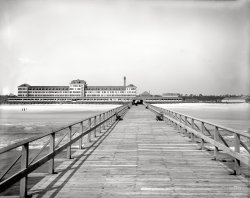
- Rice Creek: 1890s
- ... St. Johns River near Palatka. 8x10 inch glass negative by William Henry Jackson. View full size.
Always the artist I'm most familiar ... Posted by Dave - 05/18/2014 - 12:31am -
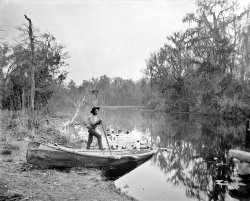
- Mammoth Plates: 1891
- ... flooding. Note the giant camera and tripod employed by William Henry Jackson in the making of his heroically proportioned photographs, the ... Posted by Dave - 08/13/2012 - 7:56pm -
![Mammoth Plates: 1891 Mexico circa 1891. "Ferrocarill Central Mexicano. Canal of Nochistongo," a drainage excavated in the 17th and 18th centuries to keep Mexico City from flooding. Note the giant camera and tripod employed by William Henry Jackson in the making of his heroically proportioned photographs, the largest of which were recorded on a medium the archivists call "mammoth plates" -- glass negatives that measured 18 by 22 inches. (This particular image was made on an 8x10 inch glass plate -- what modern photographers would consider "large format," but still only a fifth the size of an 18x22.) Detroit Publishing Co. glass negative. View full size.
Big CamerasWere those "Mammoth Plate" cameras custom or home made or were they available commercially?
ImpressiveI used to shoot a lot of landscapes in large format (4x5) before the digital age hit photography. I can identify with these gents lugging all that equipment around but not to the extent they did. I cannot imagine 18x22 in the field. My hat's off to them. That's an extremely hard thing to do.
Unsteady footingOne slip, and goodbye large format camera, tripod and photographer!
PerspectiveIs anyone fooled by the perspective here? It doesn't look like that ledge is tall enough for the train to look as tiny as it does!
The Big Picture>> Were those "Mammoth Plate" cameras custom or home made or were they available commercially?
If you were a photographer in the mid 19th century you'd most likely buy a prefab lens assembly and make the box yourself (not that complicated, as most cameras then didn't have shutters), or have one made to your specification. After the Civil War, American Optical, Scovill and the Henry Clay Co. were among the commercial makers of big view and box cameras. A nice selection here.
Rapido corren los carrosMakes me think of a rolling "rrrrrr" tongue-twister a Mexican priest taught me many years ago: "Rapido corren los carros cargados de azucar de los ferrocarriles."
Glass PlatesGlass plates were coated on the spot. Or at least the night before. The glass was the expensive part, the silver nitrate emulsion came in either screw top tins or light tight jars, and were coated in the field. If the plate negative was not satisfactory it was a simple matter to strip the emulsion, recoat the glass plate and try again.
[You're thinking of the wet-plate negatives used around the time of the Civil War. Most glass plates made after 1880 (including this one) are dry-plate negatives -- coated with emulsion by the manufacturer and presensitized. - Dave]
Little Town in the backgroundI like how you can make out the little town in the background of the photo. You can see the big church with its dome and towers.
Very nice picture. I wonder where in Mexico this was taken.
Nochistongo CutThe little town in the background distance of the photo is Huehuetoca, State of Mexico. The domed church that you can see in the distance is still there and can be located near the center of town on google maps. This impressive ditch called the Nochistongo Cut (El Tajo de Nochistongo) was dug by hand (mostly indigenous near slaves) starting, if I recall correctly, in about 1607 and took about 120 years to complete. It is said that up to 30,000 laborers were worked to death in the process, though I haven’t seen any historical texts confirming it. Considering the times & place it could easily be true. It’s about 45 miles from Mexico City and is visible (the ditch) in satellite view though the waterway is obscured by trees & bushes. The railroad still passes there but there are 4 lines now. The area is rapidly filling up with outer suburbs of the capital. It was dug in an effort to relieve the severe flooding Mexico City was subject to ever since the Spanish conquest, when the Spaniards as a tactic destroyed some of the protective dikes the Aztecs and their precursors had erected to regulate water flow in the Valley of Mexico and then proceeded to erect their own capital city on the ruins. Ultimately the cut was not successful at stopping the flooding, as Mexico City was sinking slowly into the mud of the ancient lake beds, leaving the drainage collectors too high to drain all of the low areas of the city.
(The Gallery, DPC, Railroads, W.H. Jackson)](https://www.shorpy.com/files/images/4a03443a.thumbnail.jpg)
- The Ormond: 1894
- ... Ormond Beach, Florida, 1894. "The Ormond." At its peak, Henry Flagler's Hotel Ormond was reputed to be the largest wooden structure ... and breezeways. 8x10 inch dry plate glass negative by William Henry Jackson. View full size.
All that wood and it did ... Posted by Dave - 04/10/2019 - 1:18pm -
